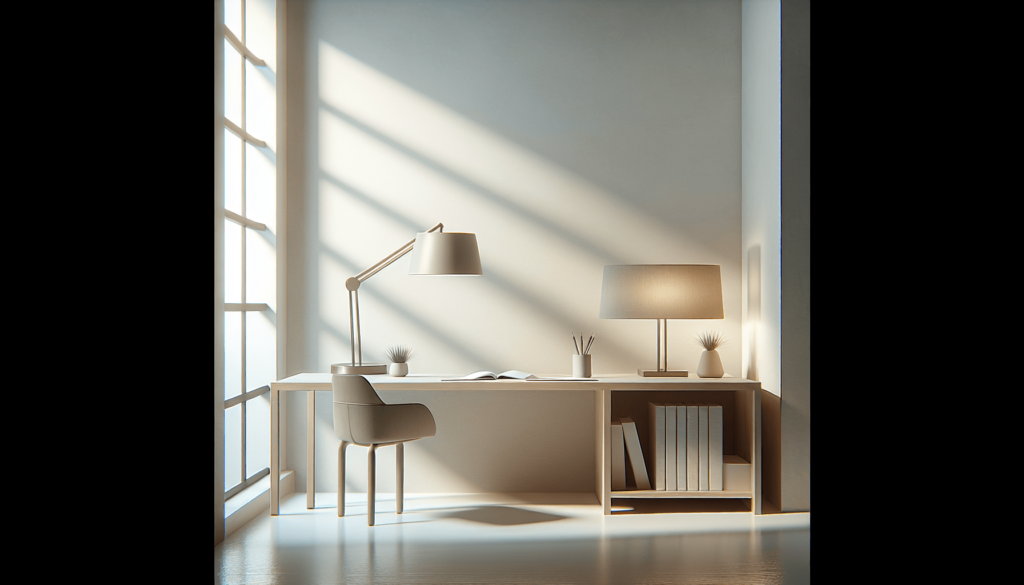Creating the perfect lighting in your home office can significantly impact your productivity, focus, and overall well-being. In this comprehensive guide, you will discover essential tips on how to effectively light your workspace, ensuring optimal comfort and a visually appealing environment. From understanding the different types of lighting to implementing the right fixtures and colors, this article will serve as your ultimate resource for transforming your home office into a well-lit haven that inspires productivity and sparks creativity.

Choosing the Right Lighting Fixtures
Consider Natural Lighting
When setting up your home office, the first thing you should consider is the natural lighting in the room. Position your desk near a window to allow for ample natural light during the day. Natural light not only provides a pleasant and energizing atmosphere but also helps improve your mood and productivity. Make sure to arrange your desk and computer in such a way that you avoid direct sunlight hitting your screen, which can cause glare and make it difficult to see.
Select Task Lighting
Task lighting is essential for focused work and preventing eye strain. Choose a desk lamp that provides direct light to your work surface. Adjustable desk lamps are particularly useful as they allow you to angle the light exactly where you need it. Look for lamps with adjustable brightness settings so you can control the amount of light based on the task at hand.
Opt for Ambient Lighting
In addition to natural and task lighting, it’s important to incorporate ambient lighting in your home office. Ambient lighting provides overall illumination and helps create a cozy and well-balanced atmosphere. Consider installing ceiling lights or wall sconces that provide even and diffused light throughout the room. This type of lighting is ideal for when you’re not working on specific tasks but still need adequate visibility in the space.
Positioning Your Lighting Fixtures
Place Desk Lamp Correctly
Proper positioning of your desk lamp is key to ensure optimal lighting conditions. The lamp should be placed on the opposite side of your dominant hand to avoid casting shadows when writing or reading. Position it at a comfortable height, so the light falls evenly on your work surface without causing any glare. Experiment with different angles and heights until you find the most suitable position for your needs.
Ensure Balanced Lighting
To prevent eye strain and ensure visual comfort, it’s important to achieve a balanced lighting setup in your home office. This means avoiding stark contrasts between the brightness of your screen and the surrounding environment. If your workspace is significantly brighter or darker than your computer screen, it can strain your eyes and make it challenging to focus. Adjust the brightness of your desk lamp and ambient lighting to match the brightness of your screen for a harmonious balance.
Avoid Glare and Shadows
Glare and shadows can be irritating and distracting when working in your home office. Position your lighting fixtures in a way that minimizes glare on your computer screen or reflective surfaces. Use shades, diffusers, or frosted bulbs to soften the light and reduce the likelihood of glare. Additionally, arrange your workspace so that there are no objects or obstructions casting shadows on your work surface.
Selecting the Right Bulbs
Choose the Right Color Temperature
Color temperature plays a significant role in creating a comfortable and productive working environment. Opt for bulbs with a color temperature between 4000K and 5000K, which provide a cool white light similar to daylight. This color temperature promotes focus and alertness, making it ideal for task-oriented work. Avoid bulbs with color temperatures below 3000K or above 6000K, as they can cause eye strain and negatively impact your concentration.
Consider the Bulb Brightness
The brightness of your bulbs can have a substantial effect on your overall lighting quality. For your home office, aim for a bulb that offers sufficient brightness without being too harsh or overwhelming. Consider bulbs with a lumen output between 800 and 1200 lumens, as this range provides an adequate level of illumination for most tasks. Remember to adjust the brightness of your task and ambient lighting based on your specific needs and preferences.
Go for Energy-Efficient Bulbs
When selecting bulbs for your home office, it’s important to choose energy-efficient options. LED bulbs are an excellent choice as they consume less energy than traditional incandescent or fluorescent bulbs. LED bulbs also last longer, saving you money on replacements and reducing environmental impact. Look for bulbs with an ENERGY STAR certification, which indicates they meet specific energy efficiency criteria set by the Environmental Protection Agency.
Utilizing Window Coverings
Use Drapes and Blinds
Window coverings such as drapes and blinds are essential for controlling the amount of natural light entering your home office. These coverings allow you to adjust the level of brightness and privacy based on your needs. When selecting drapes or blinds, opt for light-filtering options that still allow some natural light to enter the room. This way, you can enjoy the benefits of natural lighting without it being too harsh or causing glare on your computer screen.
Install Sheer Curtains
Sheer curtains are a fantastic option for diffusing direct sunlight and creating a soft, diffused glow in your home office. They provide a layer of privacy while still allowing plenty of natural light to filter through. Sheer curtains also add a touch of elegance and sophistication to your workspace, enhancing its overall aesthetic. Consider selecting a sheer curtain color that complements your existing interior design and contributes to a visually appealing and inviting atmosphere.
Consider Window Films
Window films are an excellent choice if you want to control the amount of natural light without completely blocking the view outside. These films can reduce glare, filter out harmful UV rays, and even provide an additional layer of insulation for your windows. Select a window film that offers a high level of light transmission while still providing the necessary privacy and protection. With window films, you can customize the amount of light entering your home office with ease.

Using Lighting Controls
Install Dimmer Switches
Dimmer switches allow you to adjust the intensity of your lighting fixtures according to your needs and preferences. Installing a dimmer switch for your desk lamp and ambient lighting can help create a more versatile and adaptable workspace. Dimmed lighting can be advantageous during periods of deep focus or when you want to create a more relaxed atmosphere. With a dimmer switch, you can easily transition from bright, task-oriented lighting to a softer, more ambient light whenever desired.
Set up Smart Lighting Systems
Smart lighting systems are a modern and convenient way to control your home office lighting. These systems allow you to adjust the brightness, color temperature, and even schedule on/off times for your lights using a smartphone app or voice commands. Some smart lighting systems also offer features like motion sensors or the ability to sync your lights with your computer’s screen, creating a seamless and immersive lighting experience. Explore different smart lighting options to find one that suits your preferences and budget.
Use Timers or Motion Sensors
Timers and motion sensors are practical solutions for automating your home office lighting. Set up timers to turn on and off your desk lamp or ambient lighting at specific times, ensuring you always have adequate illumination when needed. Motion sensors can detect activity in the room, automatically turning on the lights when you enter and switching them off when you leave. These technologies not only provide convenience but also help conserve energy by ensuring lights are not left on unnecessarily.
Considering Adjustable Lighting
Get an Adjustable Desk Lamp
An adjustable desk lamp is a versatile lighting fixture that allows you to direct the light precisely where you need it. Look for models with adjustable arms, heads, and height settings, giving you the flexibility to position the light exactly as desired. This feature is particularly useful when transitioning between different tasks or needing extra light for intricate work. An adjustable desk lamp ensures optimal lighting conditions at all times, reducing eye strain and improving overall comfort.
Invest in Task Lighting with Adjustable Arms
Task lighting with adjustable arms is an excellent choice for home offices with multiple workstations or shared spaces. These lighting fixtures typically feature multiple light sources and adjustable arms, allowing each user to customize the lighting according to their preferences. Whether you’re working alone or collaboratively, having individual control over the lighting ensures everyone can work comfortably and productively. Adjustable task lighting provides versatility and accommodates different work styles and needs.
Consider Height-Adjustable Floor Lamps
Height-adjustable floor lamps are an excellent option if you prefer the flexibility of having lighting at various heights in your home office. These lamps usually feature a telescoping or adjustable rod, allowing you to modify the lamp’s height to suit your specific requirements. With a height-adjustable floor lamp, you can position the light at different levels, making it useful for both task-oriented and ambient lighting purposes. This versatility ensures you have the right level of illumination, regardless of the type of work you’re performing.

Taking Ergonomics into Account
Avoid Direct Glare on the Screen
When setting up your home office lighting, it’s crucial to ensure there is no direct glare on your computer screen. Glare can cause eye fatigue, headaches, and make it challenging to see the screen clearly. Position your desk lamp and adjust its angle to minimize any glare on your screen or reflective surfaces. Consider using an anti-glare screen protector for your monitor or investing in a monitor hood to further reduce the impact of glare.
Ensure Uniform Lighting
To maintain optimal visual comfort, ensure your home office has uniform lighting throughout the space. Avoid having significant differences in brightness levels between different areas of the room. Different brightness levels can strain your eyes as they constantly adjust to varying light intensities. Arrange your lighting fixtures strategically so that all areas of your workspace receive an even amount of light, creating a consistent and well-lit environment.
Adjust Lighting for Comfortable Reading
If you frequently read physical documents or books in your home office, it’s essential to have appropriate lighting for comfortable reading. Place a task light with adjustable brightness and directionality near your reading area. This will ensure that the text is well-illuminated, minimizing eye strain and allowing for clear and effortless reading. Opt for warm white bulbs for reading, as they create a cozy and inviting atmosphere that promotes relaxation and focus.
Enhancing the Lighting Design
Add Accent Lighting
To elevate the overall atmosphere of your home office, consider incorporating accent lighting into your lighting design. Accent lighting can be achieved through the use of spotlights, wall sconces, or even decorative lamps. Use accent lighting to highlight artwork, plants, or any architectural features in your workspace. This additional layer of lighting not only adds visual interest but also creates a more inviting and dynamic environment.
Use Decorative Lighting Fixtures
Incorporating decorative lighting fixtures can significantly enhance the aesthetic appeal of your home office. Pendant lights, chandeliers, or unique table lamps can serve as both functional lighting and statement pieces. Look for fixtures that align with your personal style and complement your existing decor. By introducing decorative lighting, you can transform your home office into a stylish and inspiring space where you enjoy spending time.
Incorporate Light-Reflecting Surfaces
Maximize the effectiveness of your lighting by incorporating light-reflecting surfaces in your home office. Add mirrors, glossy furniture, or metallic accents that can bounce light around the room and amplify the illumination. Light-reflecting surfaces help distribute light more evenly and make the space appear brighter and more expansive. Additionally, these surfaces contribute to a visually appealing environment by adding a touch of elegance and sophistication.

Reducing Eye Strain
Position Lighting Properly
Proper positioning of your lighting fixtures is crucial for reducing eye strain in your home office. Ensure that there are no direct light sources aimed directly at your eyes or onto your computer screen. Position your desk lamp slightly above eye level to direct the light downward and onto your work surface. By positioning your lighting correctly, you can minimize glare, shadows, and other potential causes of eye strain.
Use Task Lighting for Focused Work
When working on tasks that require intense focus, rely on task lighting to provide targeted and sufficient illumination. Task lighting ensures that the area you’re working on is properly illuminated without compromising the overall lighting balance in the room. By using task lighting, you can avoid straining your eyes by relying solely on the ambient or overhead lighting. Adjust the intensity of your task light according to the nature of the task, ensuring just the right amount of light is provided for optimum visibility and concentration.
Take Breaks and Blink Regularly
While proper lighting is crucial, it’s also essential to take regular breaks to rest your eyes and prevent strain. Staring at a screen or focusing on close-up tasks for extended periods can cause eye fatigue and dryness. Make it a habit to take short breaks every 20 minutes, focusing on distant objects or simply closing your eyes for a few seconds. Additionally, remember to blink regularly to keep your eyes lubricated and minimize discomfort. Simple habits like these can significantly reduce eye strain and improve your overall eye health.
Getting Professional Help
Consult a Lighting Designer
If you’re unsure about how to optimize your home office lighting or want to create a more customized lighting solution, consider consulting a lighting designer. Lighting designers specialize in creating lighting schemes that enhance both aesthetics and functionality. They can assess your space, recommend suitable fixtures, and provide expert advice on how to achieve the desired lighting ambiance. Investing in professional guidance can transform your home office into a beautifully lit workspace that meets all your specific needs.
Consider Hiring an Electrician
When it comes to installing or modifying lighting fixtures in your home office, hiring an electrician is often the safest and most efficient option. Electricians have the expertise and knowledge to handle electrical installations and ensure they comply with safety regulations. They can assist with wiring, installing new lighting fixtures, or improving existing electrical connections. By hiring an electrician, you can have peace of mind knowing that your home office lighting is professionally installed and designed to operate safely and effectively.
Ask for Expert Advice
If you have specific concerns or questions regarding your home office lighting, do not hesitate to seek expert advice. Reach out to lighting retailers or professionals in the industry who can provide helpful recommendations and guidance. They can assist you in selecting the right lighting fixtures, bulbs, or control systems based on your requirements and preferences. Expert advice can save you time, money, and potential frustration, ensuring that your home office lighting setup meets your expectations and works seamlessly for your needs.
In conclusion, choosing the right lighting fixtures and optimizing their position in your home office is essential for creating a functional, comfortable, and visually appealing workspace. By considering natural lighting, selecting the right bulbs, utilizing window coverings, using lighting controls, and taking ergonomics into account, you can create the ideal lighting setup for your home office. Enhancing the lighting design, reducing eye strain, and seeking professional help when needed are additional steps you can take to ensure an optimal lighting experience in your workspace. With the right lighting, you can enhance productivity, promote well-being, and create an inviting environment for all your home office activities.



